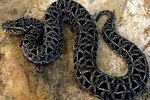
Burmese pythons (Python bivittatus) are one of the largest snake species in the world. Burmese pythons grow quickly while young, but like most snakes, this rapid growth diminishes sharply once adulthood is reached. Prospective Burmese python owners must consider not only the eventual size of these snakes, but their capacity for achieving this size quickly.
Classification and Confusion
Burmese pythons are native to the forests of Thailand, Indonesia, Myanmar, Laos, southern China and Vietnam. The Burmese python was long considered a subspecies of the Indian python (Python molurus) -- a very similar snake found to the west of the Burmese python's range. Old texts frequently use the terms Indian python, Burmese python and Asian rock python interchangeably.
Wild Growth Rate
Little research has been conducted on the growth rates of wild snakes, and while there is conjecture that captive snakes grow more quickly than wild snakes, there's little data to support this. While a variety of predators hunt young Burmese pythons, large adults have few predators besides humans, so the snakes benefit from growing as quickly as possible. The Animal Diversity Web, maintained by the University of Michigan, cites an older publication by the American Museum of Natural History, which states that Burmese pythons mature in two to three years.
Laboratory Conditions
In a study published in the January 2001 issue of “The Journal of Experimental Biology,” J. Matthias Starck and Kathleen Beese studied the effects of food on the intestinal growth of Burmese pythons. At the beginning of the study, a subset of snakes measured approximately 3 feet in length at 9 months of age. At the end of the study, approximately 2 1/2 years later, the snakes measured about 10 feet. The snakes increased in mass an average of almost 2 pounds per 100 days, or about seven pounds per year. The snakes in the study were fed prey of varying size, at intervals of 12 to 125 days.
Growth in Captivity
Skilled keepers provide captive Burmese pythons with near perfect conditions; accordingly, captive animals likely grow more quickly than their wild counterparts. Through the desire to have a large pet and the entertainment value of watching a snake eat, many captives eat much more often than their wild brethren. Additionally, captive pythons are typically provided with access to constant heat and digest food more quickly than wild snakes. Well-fed, captive hatchlings can double their size in a matter of weeks, reaching 6 feet in length before they are 6 months old. According to a 1998 article published in “Reptiles” magazine, noted python breeder Bob Clark estimates that many Burmese pythons reach 10 feet around their first birthday.
Genetic Factors Influence Growth
There is great variation in growth rate and size among Burmese pythons. A 2007 study, published in “Comparative Biochemistry and Physiology” by Christian L. Cox and Stephen M. Secor, found that the genetic potential of a given snake is one of the most important factors affecting growth rate. In the study, Cox and Secor found the metabolic rate of snakes differed from one clutch of siblings to the next. Lower metabolic rates allow for quicker growth, but feeding frequency and prey size had little to no effect on growth rate as long as a similar overall food quantity was provided.
Eventual Size
The adult size of Burmese pythons is widely exaggerated. According to David G. Barker, et al., in a 2012 paper published in “Bulleting of the Chicago Herpetological Society,” the longest verifiable length for a Burmese python is less than 20 feet. Nevertheless, Burmese pythons are large snakes that commonly reach more than 12 feet in length and sometimes exceed 200 pounds in weight. The longest recorded Burmese python was a captive animal in Illinois that measured more than 18 feet. This animal, as with many other old captive snakes, was very overweight, tipping the scales at 400 pounds.
References
- Reptiles Magazine: The Burmese Python - Making it at Home in Your Home
- Journal of Experimental Biology: Structural Flexibility of the Intestine of Burmese Python in Response to Feeding
- Comparative Biochemistry and Physiology Part A: Effects of Temperature on the Metabolic Response to Feeding in Python Molurus
- Comparative Biochemistry and Physiology Part A: Effects of Meal Size, Clutch, and Metabolism on the Energy Efficiencies of Juvenile Burmese Pythons, Python Molurus
- National Geographic: Burmese Python
- Bulletin of the Chicago Herpetological Society: The Corrected Lengths of Two Well-known Giant Pythons and the Establishment of a New Maximum Length Record for Burmese Pythons, Python Bivittatus
- Bulletin of the Chicago Herpetological Society: The Distribution of the Burmese Python, Python Bivittatus, in China
- Animal Diversity Web: Python Molurus
Photo Credits
-
Jupiterimages/Photos.com/Getty Images




